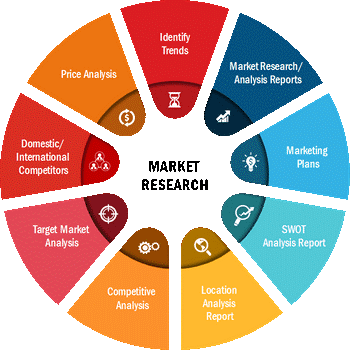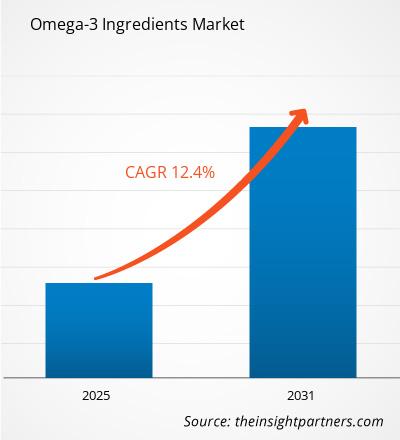美国 omega-3 成分市场预计将从 2022 年的 30 亿美元增长到美国到 2031 年,预计将达到 60 亿美元,2022 年至 2031 年复合年增长率预计为 12.4%。
Omega-3 成分由二十碳五烯酸 (EPA)、二十二碳六烯酸 (DHA) 和 α-亚麻酸 (ALA) 组成,是维持整体健康所必需的。 Omega-3成分不能由人体合成,因此个人需要通过不同的膳食补充剂来补充饮食,这些补充剂可以以甜点、果汁等形式食用。
市场动态
近年来,人们的健康意识显着提高,因为现在人们无法专注于自己的健康、健身和规律饮食通过忙碌的生活方式和繁忙的工作日程。结果,肥胖、糖尿病、高血压、皮肤问题、消化问题和其他疾病的患病率大幅上升。由此,预防保健品和膳食补充剂受到了大众的欢迎。 Omega-3成分主要用于营养补充剂的商业合成。 2021年,美国食品和药物管理局(FDA)宣布了在食品和膳食补充剂中使用omega-3成分的新健康声明,旨在避免高血压和冠心病的风险。
< p>市场范围“全球”Omega-3 成分市场到 2031 年分析》是对 omega-3 成分市场的专业和深入研究,特别关注全球市场趋势分析。该报告旨在提供市场概况和详细细分。它提供了有关主要市场参与者状况的关键统计数据,并描述了市场的主要趋势和机会。
战略洞察
市场细分
全球欧米茄-3 成分市场根据类型、来源和应用进行细分。根据类型,市场分为二十碳五烯酸 (EPA)、二十二碳六烯酸 (DHA) 和 α-亚麻酸 (ALA)。就来源而言,市场分为植物和海洋。植物市场进一步分为亚麻籽、奇亚籽、核桃等,而海洋部分进一步分为鱼、藻类、磷虾等。根据应用,omega-3 成分市场分为食品和食品。饮料、药品和营养保健品等。食品和饮料市场饮料细分市场细分为婴儿配方奶粉、油脂、乳制品和冷冻甜点、饮料等。
omega-3 成分市场分为五个主要区域:北美、欧洲、亚太地区 (APAC)、中东和非洲。非洲 (MEA) 和南美洲中美洲。该报告对18个国家的市场进行了分析和预测,以及主要地区的当前趋势和机遇。
北美在 2021 年主导了 omega-3 成分市场。Omega 3 成分主要在北美提取和加工,因为大量膳食补充剂制造商和化学加工公司在北美开展业务该区域。由于神经系统疾病患病率不断上升,美国消费者对 omega-3 成分的兴趣与日俱增。美国心脏协会 (AHA) 建议人们每周吃两次鱼,尤其是冷水鱼,以保持饮食中最佳的 omega-3 水平。此外,医疗保健支出的增加、饮食习惯的改变以及人均收入的增加是支持北美 omega-3 成分市场增长的几个关键因素。
来源:Insight Partners 分析
< p>该报告分析了影响 omega-3 成分市场的关键因素的驱动因素、限制因素、机遇和未来趋势。它还提供了详尽的波特五力分析,突出显示了影响这些地区市场的因素。COVID-19 大流行的影响
COVID-19 大流行对整个 omega-3 成分市场产生了复杂的影响。封锁的实施导致各种制造活动暂时停止,供应链中断,从而严重影响了 omega-3 成分市场。此外,旅行限制导致原材料运输的不规范和不确定性。然而,在这场全球健康危机期间,消费者开始高度关注自己的健康和健身,这推动了对增强免疫力的保健品的需求。此外,人们开始更加注重身心健康,通过瑜伽、锻炼和尊巴舞等活动来改善健康,这为功能性食品和饮料制造商创造了巨大的机会。 Omega-3 成分广泛用于功能性食品和饮料中。食品和饮料制造商饮料和营养保健品行业越来越多地将 omega-3 成分作为其产品的主要营养来源。
2021 年,随着各国政府宣布放松包括封锁在内的多项社会限制,全球市场出现复苏。制造商满负荷恢复生产,这有助于他们克服供需缺口。许多公司还扩大了生产能力,以满足消费者对 omega-3 成分不断增长的需求。
市场参与者
报告重点介绍了 omega-3 成分市场中各公司采取的关键有机和无机增长战略。许多公司都专注于有机增长战略,例如产品发布和批准、专利和活动。收购、合作和合作是市场上常见的无机增长策略。有机和无机活动都为业务和客户群的扩展铺平了道路。
这份关于 omega-3 成分市场的报告包括主要公司简介及其 SWOT 分析和市场策略。它重点关注领先市场参与者的公司概况、组件和服务产品、财务信息(过去三年)以及主要发展(过去五年)。
Omega-3 成分市场中的主要公司
- 嘉吉公司
- 巴斯夫公司
- Pharma Marine AS
- 禾大国际有限公司
- POLARIS
- Epax
- DSM
- 欧米茄蛋白
- Cellana Inc
- Clover Corporation Limited
The Insight Partners 的专业研究和分析团队由经验丰富的专业人士组成,拥有先进的统计专业知识,他们在现有研究中提供各种定制选项。
- 历史分析(2 年)、基准年、预测(7 年)及复合年增长率
- PEST 和 SWOT 分析
- 市场规模价值/数量 - 全球、区域、国家
- 行业和竞争格局
- Excel 数据集



Report Coverage
Revenue forecast, Company Analysis, Industry landscape, Growth factors, and Trends

Segment Covered
This text is related
to segments covered.

Regional Scope
North America, Europe, Asia Pacific, Middle East & Africa, South & Central America

Country Scope
This text is related
to country scope.
Trends and growth analysis reports related to Food and Beverages : READ MORE..
The List of Companies
1. Arista Industries
2. Copeinca ASA
3. Croda, Inc
4. FMC Corporation,
5. Koninklijke DSM N.V
6. Neptune Wellness Solutions Inc
7. NU-MEGA Ingredients Pty Ltd
8. Omega Protein Corporation
9. Polaris S.A
10. Pronova BioPharma ASA
The Insight Partners performs research in 4 major stages: Data Collection & Secondary Research, Primary Research, Data Analysis and Data Triangulation & Final Review.
- Data Collection and Secondary Research:
As a market research and consulting firm operating from a decade, we have published and advised several client across the globe. First step for any study will start with an assessment of currently available data and insights from existing reports. Further, historical and current market information is collected from Investor Presentations, Annual Reports, SEC Filings, etc., and other information related to company’s performance and market positioning are gathered from Paid Databases (Factiva, Hoovers, and Reuters) and various other publications available in public domain.
Several associations trade associates, technical forums, institutes, societies and organization are accessed to gain technical as well as market related insights through their publications such as research papers, blogs and press releases related to the studies are referred to get cues about the market. Further, white papers, journals, magazines, and other news articles published in last 3 years are scrutinized and analyzed to understand the current market trends.
- Primary Research:
The primarily interview analysis comprise of data obtained from industry participants interview and answers to survey questions gathered by in-house primary team.
For primary research, interviews are conducted with industry experts/CEOs/Marketing Managers/VPs/Subject Matter Experts from both demand and supply side to get a 360-degree view of the market. The primary team conducts several interviews based on the complexity of the markets to understand the various market trends and dynamics which makes research more credible and precise.
A typical research interview fulfils the following functions:
- Provides first-hand information on the market size, market trends, growth trends, competitive landscape, and outlook
- Validates and strengthens in-house secondary research findings
- Develops the analysis team’s expertise and market understanding
Primary research involves email interactions and telephone interviews for each market, category, segment, and sub-segment across geographies. The participants who typically take part in such a process include, but are not limited to:
- Industry participants: VPs, business development managers, market intelligence managers and national sales managers
- Outside experts: Valuation experts, research analysts and key opinion leaders specializing in the electronics and semiconductor industry.
Below is the breakup of our primary respondents by company, designation, and region:

Once we receive the confirmation from primary research sources or primary respondents, we finalize the base year market estimation and forecast the data as per the macroeconomic and microeconomic factors assessed during data collection.
- Data Analysis:
Once data is validated through both secondary as well as primary respondents, we finalize the market estimations by hypothesis formulation and factor analysis at regional and country level.
- Macro-Economic Factor Analysis:
We analyse macroeconomic indicators such the gross domestic product (GDP), increase in the demand for goods and services across industries, technological advancement, regional economic growth, governmental policies, the influence of COVID-19, PEST analysis, and other aspects. This analysis aids in setting benchmarks for various nations/regions and approximating market splits. Additionally, the general trend of the aforementioned components aid in determining the market's development possibilities.
- Country Level Data:
Various factors that are especially aligned to the country are taken into account to determine the market size for a certain area and country, including the presence of vendors, such as headquarters and offices, the country's GDP, demand patterns, and industry growth. To comprehend the market dynamics for the nation, a number of growth variables, inhibitors, application areas, and current market trends are researched. The aforementioned elements aid in determining the country's overall market's growth potential.
- Company Profile:
The “Table of Contents” is formulated by listing and analyzing more than 25 - 30 companies operating in the market ecosystem across geographies. However, we profile only 10 companies as a standard practice in our syndicate reports. These 10 companies comprise leading, emerging, and regional players. Nonetheless, our analysis is not restricted to the 10 listed companies, we also analyze other companies present in the market to develop a holistic view and understand the prevailing trends. The “Company Profiles” section in the report covers key facts, business description, products & services, financial information, SWOT analysis, and key developments. The financial information presented is extracted from the annual reports and official documents of the publicly listed companies. Upon collecting the information for the sections of respective companies, we verify them via various primary sources and then compile the data in respective company profiles. The company level information helps us in deriving the base number as well as in forecasting the market size.
- Developing Base Number:
Aggregation of sales statistics (2020-2022) and macro-economic factor, and other secondary and primary research insights are utilized to arrive at base number and related market shares for 2022. The data gaps are identified in this step and relevant market data is analyzed, collected from paid primary interviews or databases. On finalizing the base year market size, forecasts are developed on the basis of macro-economic, industry and market growth factors and company level analysis.
- Data Triangulation and Final Review:
The market findings and base year market size calculations are validated from supply as well as demand side. Demand side validations are based on macro-economic factor analysis and benchmarks for respective regions and countries. In case of supply side validations, revenues of major companies are estimated (in case not available) based on industry benchmark, approximate number of employees, product portfolio, and primary interviews revenues are gathered. Further revenue from target product/service segment is assessed to avoid overshooting of market statistics. In case of heavy deviations between supply and demand side values, all thes steps are repeated to achieve synchronization.
We follow an iterative model, wherein we share our research findings with Subject Matter Experts (SME’s) and Key Opinion Leaders (KOLs) until consensus view of the market is not formulated – this model negates any drastic deviation in the opinions of experts. Only validated and universally acceptable research findings are quoted in our reports.
We have important check points that we use to validate our research findings – which we call – data triangulation, where we validate the information, we generate from secondary sources with primary interviews and then we re-validate with our internal data bases and Subject matter experts. This comprehensive model enables us to deliver high quality, reliable data in shortest possible time.

 获取此报告的免费样本
获取此报告的免费样本